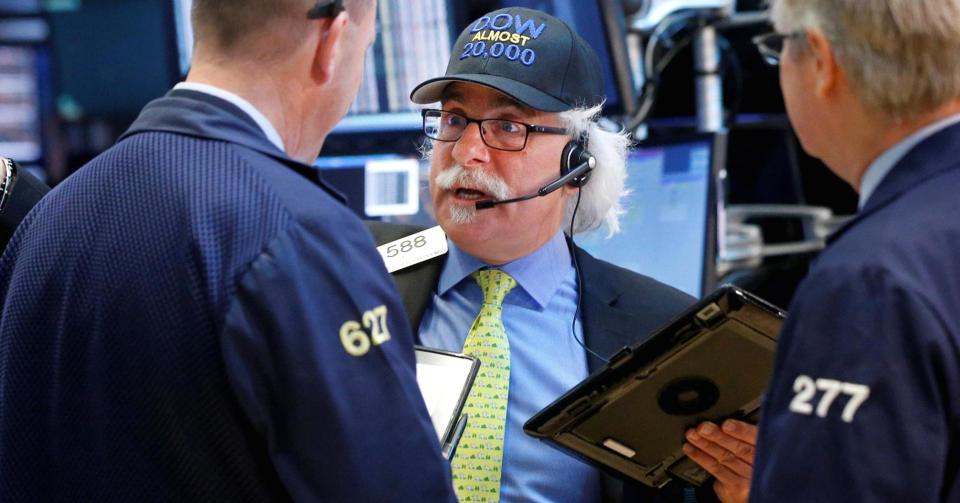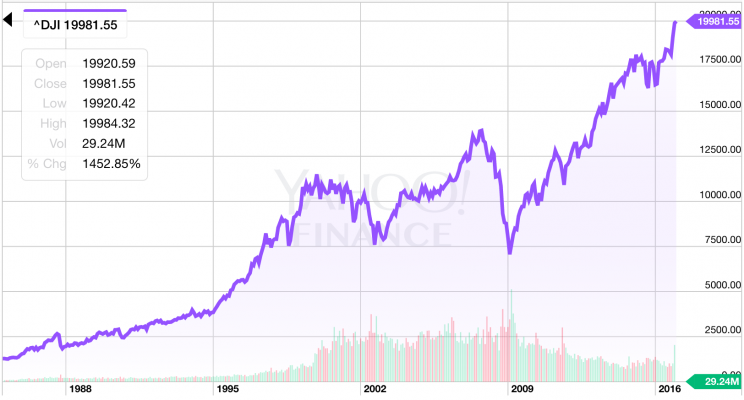The Dow is closing in on 20,000...

The Dow Jones Industrial Average is closing on 20,000.
On Wednesday morning, the Dow traded as high as 19,985 shortly after the market open, gaining about 10 points on the session.
This latest push towards 20,000 follows last week’s failed effort at the milestone and comes on the heels of a furious post-election rally that has seen the blue chip index gain about 1,600 points.
Year-to-date, the Dow is now up more than 14%.
“In one word, we can describe the driver of the most recent leg of the second-longest Bull Market Run in history: OPTIMISM,” writes Rich Barry, floor governor at the New York Stock Exchange.
Since the post-crisis bottom in stocks was reached back in March 2009, we’ve seen the Dow gain 180% and the S&P 500 gain 200% over the intervening seven-and-a-half years. The Dow first eclipsed the 10,000 mark in March 1999.
And since the presidential election we’ve seen, perhaps for the first time during the length of this bull market yet, something like real investor enthusiasm in the market.

“Given the market’s steep advance since election day, many are questioning the sustainability of valuations and whether the rally has gotten ahead of itself,” Jonathan Golub, chief equity strategist at RBC Capital Markets, wrote in a note to clients last week.
“In a nutshell, we believe that we are in the early days of this rotation.”
For Golub, the market rally comes down to investors betting on better economic growth, more inflation, and lower taxes. The market, in other words, is betting on Trumponomics.
Golub added that, “Analysts tend to be cautious in adjusting estimates following breaking news, acting only after ascertaining company-specific impacts. Investors, by contrast, are quicker to respond to incomplete information.
“This dynamic is playing out post-election, with stocks sharply higher while estimates remain largely unchanged. This timing difference creates the false impression that valuations are stretched, and should correct as analysts catch up to the market.” (Emphasis added.)
There is also nothing inherently meaningful about the Dow hitting 20,000 beyond it being a reflection of how much investors want to pay for a cut of future corporate profits. As a psychological mile-marker Dow 20,000 does matter.
The Dow is the people’s index and is the one you’re most likely to find quoted in non-financial news reports about the stock market. And while this fact certainly rankles market participants who know the cap-weighting of the Dow is sort of nonsensical, or that the Wilshire 5000 is the real way to capture the total US stock market, public perception matters.
And a big round number like 20,000 is sure to catch the public’s eye.
Facts and figures
The Dow has been around since 1896, and General Electric is the only one of the index’s original 12 members you’d still recognize by name today.
Via S&P Dow Jones Indices, which compiles the index, here are some of the keys facts and figures about the index through December 12, 2016:
Since its inception in 1896, the Dow’s average annual return has been 7.27%. The average daily return is .02537%, with the average positive day seeing a gain of 0.71% and the average down day seeing a loss of 0.74%.
July is the best month of the year, with an average return of 1.3192%, while September has been the index’s worst month, with an average loss of -1.0586%.
The Dow’s best year ever was 1915, when the index gained 81.66%. The Dow’s worst-ever year was 1931, when it lost 52.67%.
The index’s best decade ever was the 1990s, when it gained 317.59%. It’s worst decade was the 1930s, when the Dow lost 39.54%.

